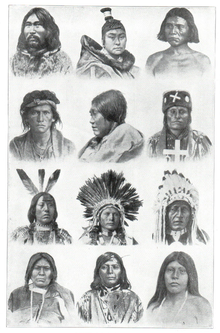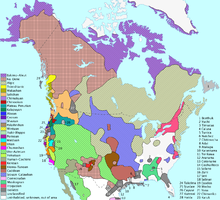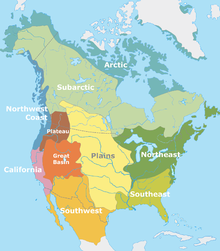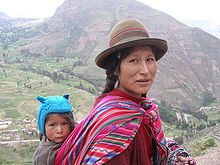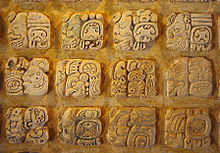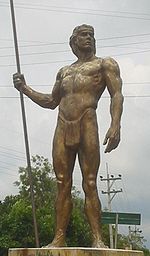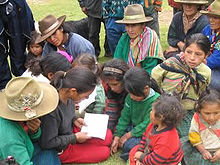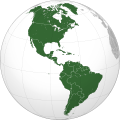- Indigenous peoples of the Americas
-
"Red Indian" redirects here. For the native inhabitants of the island of Newfoundland known for using red ochre, see Beothuk.
Indigenous peoples of the Americas Total population approximately 48 million Regions with significant populations (not including Mestizo or Zambo population)  Peru
Peru13.8 million [1]  Mexico
Mexico10.1 million [2]  Bolivia
Bolivia6 million [3]  Guatemala
Guatemala5.4 million [4]  Ecuador
Ecuador3.4 million  United States
United States2.5 million [5]  Colombia
Colombia1.4 million [6]  Canada
Canada1.2 million [7]  Brazil
Brazil700,000 [8]  Chile
Chile692,000 [9]  Argentina
Argentina600,000 [10]  Venezuela
Venezuela524,000 [11]  Nicaragua
Nicaragua443,847 [12]  Panama
Panama204,000 [13]  Paraguay
Paraguay95,235 [14]  El Salvador
El Salvador~70,000 [15] Languages Indigenous languages of the Americas Religion Inuit religion
Native American mythology
Native American religion
ChristianityThe indigenous peoples of the Americas are the pre-Columbian inhabitants of North and South America, their descendants and other ethnic groups who are identified with those peoples. The indigenous peoples of the Americas also include Iñupiat, Cup'ik/Yup'ik, Alutiiq, Aleut, Inuit, Aboriginal peoples,[16] and Native Americans,[17] also known in Canada as First Nations,[16] (by Christopher Columbus' geographic mistake) Indians,[17] Red Indians, American Indians, or Amerindians. Indigenous peoples are also known by their specific tribal and cultural ancestry and citizenship.
According to the New World migration model, a migration of humans from Eurasia to the Americas took place via Beringia, a land bridge which connected the two continents across what is now the Bering Strait. The most recent point at which this migration could have taken place is ca. 12,000 years ago, with the earliest period remaining a matter of some unresolved contention.[18][19] These early Paleo-Indians soon spread throughout the Americas, diversifying into many hundreds of culturally distinct nations and tribes.[19] According to the oral histories of many of the indigenous peoples of the Americas, they have been living there since their genesis, described by a wide range of traditional creation accounts.
Application of the term "Indian" originated with Christopher Columbus, who thought that he had arrived in the East Indies, while seeking Asia.[20][21][22][23][24][25] Later the name was still used as the Americas at the time were often called West Indies. This has served to imagine a kind of racial or cultural unity for the aboriginal peoples of the Americas. Once created, the unified "Indian" was codified in law, religion, and politics. The unitary idea of "Indians" was not originally shared by indigenous peoples, but many over the last two centuries have embraced the identity.
While some indigenous peoples of the Americas were historically hunter-gatherers, many practiced aquaculture and agriculture. The impact of their agricultural endowment to the world is a testament to their time and work in reshaping and cultivating the flora indigenous to the Americas.[26] Some societies depended heavily on agriculture while others practiced a mix of farming, hunting, and gathering. In some regions the indigenous peoples created monumental architecture, large-scale organized cities, chiefdoms, states, and empires.
Many parts of the Americas are still populated by indigenous Americans; some countries have sizable populations, especially Bolivia, Peru, Mexico, Guatemala, Colombia, and Ecuador. At least a thousand different indigenous languages are spoken in the Americas. Some, such as Quechua languages, Aymara, Guaraní, Mayan languages, and Nahuatl, count their speakers in millions. Many also maintain aspects of indigenous cultural practices to varying degrees, including religion, social organization and subsistence practices. Some indigenous peoples still live in relative isolation from Western society, and a few are still counted as uncontacted peoples.
Contents
History
Migration into the continents
For more details on theories of Paleo-Indians migration, see Settlement of the Americas.The specifics of Paleo-Indian migration to and throughout the Americas, including the exact dates and routes traveled, are subject to ongoing research and discussion.[28] The traditional Western theory has been that these early migrants moved into the Beringia land bridge between eastern Siberia and present-day Alaska around 40,000—16,500 years ago,[29][30][31][32] when sea levels were significantly lowered due to the Quaternary glaciation.[28][33] These people are believed to have followed herds of now-extinct Pleistocene megafauna along ice-free corridors that stretched between the Laurentide and Cordilleran ice sheets.[34] Another route proposed is that, either on foot or using primitive boats, they migrated down the Pacific Northwest coast to South America.[35] Evidence of the latter would since have been covered by a sea level rise of hundreds of meters following the last ice age.[36]
The time range of 40,000—16,500 years ago is a hot source of debate and will be for years to come. The few agreements achieved to date are the origin from Central Asia, with widespread habitation of the Americas during the end of the last glacial period, or more specifically what is known as the late glacial maximum, around 16,000 — 13,000 years before present.[32][37]
Stone tools, particularly projectile points and scrapers, are the primary evidence of the earliest human activity in the Americas. Crafted lithic flaked tools are used by archaeologists and anthropologists to classify cultural periods.[38] Scientific evidence links indigenous Americans to Asian peoples, specifically eastern Siberian populations. Indigenous peoples of the Americas have been linked to North Asian populations by linguistic factors, the distribution of blood types, and in genetic composition as reflected by molecular data, such as DNA.[39]
Pre-Columbian era
Main article: Pre-Columbian eraSee also: Archaeology of the AmericasThe Pre-Columbian era incorporates all period subdivisions in the history and prehistory of the Americas before the appearance of significant European and African influences on the American continents, spanning the time of the original settlement in the Upper Paleolithic to European colonization during the Early Modern period.[40]
While technically referring to the era before Christopher Columbus's voyages of 1492 to 1504, in practice the term usually includes the history of American indigenous cultures until they were either conquered or significantly influenced by Europeans, even if this happened decades or even centuries after Columbus' initial landing.[41] Pre-Columbian is used especially often in the context of the great indigenous civilizations of the Americas, such as those of Mesoamerica (the Olmec, the Toltec, the Teotihuacano, the Zapotec, the Mixtec, the Aztec, and the Maya) and the Andes (Inca, Moche, Chibcha, Cañaris).
 Paleo-Indians hunting a glyptodont
Paleo-Indians hunting a glyptodont
Many pre-Columbian civilizations established characteristics and hallmarks which included permanent or urban settlements, agriculture, civic and monumental architecture, and complex societal hierarchies.[42] Some of these civilizations had long faded by the time of the first permanent European and African arrivals (ca. late 15th–early 16th centuries), and are known only through oral history and archaeological investigations. Others were contemporary with this period, and are also known from historical accounts of the time. A few, such as the Maya, Olmec, Mixtec, and Nahua peoples, had their own written records. However, the European colonists of the time viewed such texts as heretical, and much was destroyed in Christian pyres. Only a few hidden documents remain today, leaving contemporary historians with glimpses of ancient culture and knowledge.
According to both indigenous American and European accounts and documents, American civilizations at the time of European encounter possessed many impressive accomplishments.[43] For instance, the Aztecs built one of the most impressive cities in the world, Tenochtitlan, the ancient site of Mexico City, with an estimated population of 200,000. American civilizations also displayed impressive accomplishments in astronomy and mathematics. Inuit, Alaskan Native, and American Indian creation myths tell of a variety of originations of their respective peoples. Some were "always there" or were created by gods or animals, some migrated from a specified compass point, and others came from "across the ocean".[44]
So far, the only verifiable site of "pre-Columbian" European settlement anywhere in the Western Hemisphere is L'Anse aux Meadows, located near the very northern tip of the Canadian island of Newfoundland. It was settled by the Norse around the end of the 10th century.
European colonization
Main article: European colonization of the AmericasThe European colonization of the Americas forever changed the lives, bloodlines and cultures of the peoples of the continent. The population history of American indigenous peoples postulates that infectious disease exposure, displacement, and warfare diminished populations, with the first the most significant cause.[26][45] The first indigenous group encountered by Columbus were the 250,000 Taínos of Hispaniola who were the dominant culture in the Greater Antilles and the Bahamas. In thirty years, about 70% of the Taínos died.[46] They had no immunity to European diseases, so outbreaks of measles and smallpox ravaged their population.[47] The increased ignorance towards the practice of punishing the Taínos for revolting themselves from forced labour, despite the measures brought by the encomienda which included religious education and protection from warring tribes,[48] eventually helped conceived the last great Taíno rebellion.
Mistreated, the Taínos began to adopt suicidal behaviors, with women aborting or killing their infants, men jumping from the cliffs or ingesting manioc, a violent poison.[46] Eventually, a Taíno Cacique named Enriquillo managed to hold out in the mountain range of Bahoruco for thirteen years conducting serious damage to the Spanish, Carib-held plantations and their Indian auxiliaries.[49] After hearing of the seriousness of the revolt, Emperor Charles V sent captain Francisco Barrionuevo to negotiate a peace treaty with the ever increasing number of rebels. Two months later, with the consulting of the Audencia of Santo Domingo, Enriquillo was offered any part of the island to live in peace.
The Laws of Burgos, 1512-1513 were the first codified set of laws governing the behavior of Spanish settlers in America, particularly with regards to native Indians. They forbade the maltreatment of natives, and endorsed their conversion to Catholicism.[50] The Spanish crown found it difficult to enforce these laws in a distant colony.
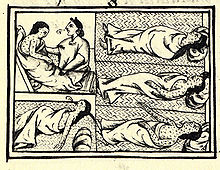 Drawing accompanying text in Book XII of the 16th-century Florentine Codex (compiled 1540–1585), showing Nahuas of conquest-era central Mexico suffering from smallpox
Drawing accompanying text in Book XII of the 16th-century Florentine Codex (compiled 1540–1585), showing Nahuas of conquest-era central Mexico suffering from smallpox
Reasons for the decline of the Native American populations are variously theorized to be from epidemic diseases, conflicts with Europeans, and conflicts among warring tribes. Scholars now believe that, among the various contributing factors, epidemic disease was the overwhelming cause of the population decline of the American natives.[51][52] After first contacts with Europeans and Africans, some believe that the death of 90 to 95% of the native population of the New World was caused by Old World diseases.[53] Half the native population of Hispaniola in 1518 was killed by smallpox.[54] Within a few years smallpox killed between 60% and 90% of the Inca population, with other waves of European disease weakening them further.[55] Smallpox was only the first epidemic. Typhus (probably) in 1546, influenza and smallpox together in 1558, smallpox again in 1589, diphtheria in 1614, measles in 1618—all ravaged the remains of Inca culture. Smallpox had killed millions of native inhabitants of Mexico.[56][57] Unintentionally introduced at Veracruz with the arrival of Pánfilo de Narváez on April 23, 1520, smallpox ravaged Mexico in the 1520s,[58] possibly killing over 150,000 in Tenochtitlan alone (the heartland of the Aztec Empire), and aided in the victory of Hernán Cortés over the Aztec empire at Tenochtitlan (present-day Mexico City) in 1521.[59]
Over the centuries, the Europeans had developed high degrees of immunity to these diseases, while the indigenous Americans had no such immunity.[60] Europeans had been ravaged in their own turn by such diseases as bubonic plague and Asian flu that moved west from Asia to Europe. In addition, when they went to some territories, such as Africa and Asia, they were more vulnerable to malaria.
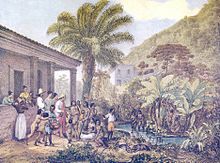 Indians visiting a Brazilian farm plantation in Minas Gerais c.1824
Indians visiting a Brazilian farm plantation in Minas Gerais c.1824
The repeated outbreaks of influenza, measles and smallpox probably resulted in a decline of between one-half and two-thirds of the Aboriginal population of eastern North America during the first 100 years of European contact.[61] In 1617–1619, smallpox reportedly killed 90% of the Massachusetts Bay Colony Native American residents.[62] In 1633, in Plymouth, the Native Americans there were exposed to smallpox because of contact with Europeans. As it had done elsewhere, the virus wiped out entire population groups of Native Americans.[63] It reached Lake Ontario in 1636, and the lands of the Iroquois by 1679.[64][65] During the 1770s, smallpox killed at least 30% of the West Coast Native Americans.[66] Smallpox epidemics in 1780–1782 and 1837–1838 brought devastation and drastic population depletion among the Plains Indians.[67][68] In 1832, the federal government of the United States established a smallpox vaccination program for Native Americans (The Indian Vaccination Act of 1832).[69][70]
In Brazil, the indigenous population has declined from a pre-Columbian high of an estimated three million to some 300,000 in 1997.[71][72]
Later explorations of the Caribbean led to the discovery of the Arawak peoples of the Lesser Antilles. The culture was destroyed by 1650. Only 500 had survived by the year 1550, though the bloodlines continued through the modern populace. In Amazonia, indigenous societies weathered centuries of colonization.[73]
The Spaniards and other Europeans brought horses to the Americas. Some of these animals escaped and began to breed and increase their numbers in the wild.[74] The re-introduction of the horse had a profound impact on Native American culture in the Great Plains of North America and of Patagonia in South America. By domesticating horses, some tribes had great success: they expanded their territories, exchanged many goods with neighboring tribes, and more easily captured game, especially bison.
Agriculture
See also: Agriculture in Mesoamerica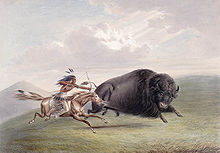 A bison hunt depicted by George Catlin
A bison hunt depicted by George Catlin
Over the course of thousands of years, American indigenous peoples domesticated, bred and cultivated a large array of plant species. These species now constitute 50–60% of all crops in cultivation worldwide.[75] In certain cases, the indigenous peoples developed entirely new species and strains through artificial selection, as was the case in the domestication and breeding of maize from wild teosinte grasses in the valleys of southern Mexico. Numerous such agricultural products retain native names in the English and Spanish lexicons.
The South American highlands were a center of early agriculture. Genetic testing of the wide variety of cultivars and wild species suggest that the potato has a single origin in the area of southern Peru,[76] from a species in the Solanum brevicaule complex. Over 99% of all modern cultivated potatoes worldwide are descendants of a subspecies indigenous to south-central Chile,[77] Solanum tuberosum ssp. tuberosum, where it was cultivated as long as 10,000 years ago.[78][79] According to George Raudzens, "It is clear that in pre-Columbian times some groups struggled to survive and often suffered food shortages and famines, while others enjoyed a varied and substantial diet."[80] The persistent drought around 850 AD coincided with the collapse of Classic Maya civilization, and the famine of One Rabbit (AD. 1454) was a major catastrophe in Mexico.[81]
Natives of North American began practicing farming approximately 4,000 years ago, late in the Archaic period of North American cultures. Technology had advanced to the point that pottery was becoming common, and the small-scale felling of trees became feasible. Concurrently, the Archaic Indians began using fire in a widespread manner. Intentional burning of vegetation was used to mimic the effects of natural fires that tended to clear forest understories. It made travel easier and facilitated the growth of herbs and berry-producing plants, which were important for both food and medicines.[82]
In the Mississippi River valley, Europeans noted Native Americans' managed groves of nut and fruit trees as orchards, not far from villages and towns, in addition to their gardens and agricultural fields. Wildlife competition could be reduced by understory burning. Further away, prescribed burning would have been used in forest and prairie areas.[83]
Many crops first domesticated by indigenous Americans are now produced and/or used globally. Chief among these is maize or "corn", arguably the most important crop in the world.[84] Other significant crops include cassava, chia, squash (pumpkins, zucchini, marrow, acorn squash, butternut squash), the pinto bean, Phaseolus beans including most common beans, tepary beans and lima beans, tomato, potatoes, avocados, peanuts, cocoa beans (used to make chocolate), vanilla, strawberries, pineapples, Peppers (species and varieties of Capsicum, including bell peppers, jalapeños, paprika and chili peppers) sunflower seeds, rubber, brazilwood, chicle, tobacco, coca, manioc and some species of cotton.
Studies of contemporary indigenous environmental management, including agro-forestry practices among Itza Maya in Guatemala and hunting and fishing among the Menominee of Wisconsin, suggest that longstanding "sacred values" may represent a summary of sustainable millennial traditions.[85]
Culture
Cultural practices in the Americas seem to have been mostly shared within geographical zones where otherwise unrelated peoples might adopt similar technologies and social organizations. An example of such a cultural area could be Mesoamerica, where millennia of coexistence and shared development between the peoples of the region produced a fairly homogeneous culture with complex agricultural and social patterns. Another well-known example could be the North American plains area, where until the 19th century, several different peoples shared traits of nomadic hunter-gatherers primarily based on buffalo hunting.
Writing systems
See also: Canadian Aboriginal syllabicsAn independent origin and development of writing is counted among the many achievements and innovations of pre-Columbian American cultures. The Mesoamerican region produced a number of indigenous writing systems from the 1st millennium BCE onwards. What may be the earliest-known example in the Americas of an extensive text thought to be writing is by the Cascajal Block. The Olmec hieroglyphs tablet has been indirectly dated from ceramic shards found in the same context to approximately 900 BCE, around the time that Olmec occupation of San Lorenzo Tenochtitlán began to wane.[86]
The Maya writing system (often called hieroglyphs from a superficial resemblance to the Ancient Egyptian writing) was a combination of phonetic symbols and logograms. It is most often classified as a logographic or (more properly) a logosyllabic writing system, in which syllabic signs play a significant role. It is the only pre-Columbian writing system known to completely represent the spoken language of its community. In total, the script has more than one thousand different glyphs, although a few are variations of the same sign or meaning, and many appear only rarely or are confined to particular localities. At any one time, no more than around five hundred glyphs were in use, some two hundred of which (including variations) had a phonetic or syllabic interpretation.
Aztec codices (singular codex) are books written by pre-Columbian and colonial-era Aztecs. These codices provide some of the best primary sources for Aztec culture. The pre-Columbian codices differ from European codices in that they are largely pictorial; they were not meant to symbolize spoken or written narratives.[87] The colonial era codices not only contain Aztec pictograms, but also Classical Nahuatl (in the Latin alphabet), Spanish, and occasionally Latin.
The Wiigwaasabak, birch bark scrolls on which the Ojibwa (Anishinaabe) people wrote complex geometrical patterns and shapes, can also be considered a form of writing, as can Mi'kmaq hieroglyphics.
Aboriginal syllabic writing, or simply syllabics, is a family of abugidas used to write a number of Aboriginal Canadian languages of the Algonquian, Inuit, and (formerly) Athabaskan language families.
Music and art
Main articles: Visual arts by indigenous peoples of the Americas and Native American music An Inukshuk ("Like a man") from Resolute Bay.
An Inukshuk ("Like a man") from Resolute Bay.
Native American music in North America is almost entirely monophonic, but there are notable exceptions. Traditional Native American music often centers around drumming. Rattles, clappersticks, and rasps were also popular percussive instruments. Flutes were made of rivercane, cedar, and other woods. The tuning of these flutes is not precise and depends on the length of the wood used and the hand span of the intended player, but the finger holes are most often around a whole step apart and, at least in Northern California, a flute was not used if it turned out to have an interval close to a half step. The Apache fiddle is a single stringed instrument.
Music from indigenous peoples of Central Mexico and Central America often was pentatonic. Before the arrival of the Spaniards and other Europeans it was inseparable from religious festivities and included a large variety of percussion and wind instruments such as drums, flutes, sea snail shells (used as a kind of trumpet) and "rain" tubes. No remnants of pre-Columbian stringed instruments were found until archaeologists discovered a jar in Guatemala, attributed to the Maya of the Late Classic Era (600–900 CE), which depicts a stringed musical instrument which has since been reproduced. This instrument is astonishing in at least two respects. First, it is one of the very few string instruments known in the Americas prior to the introduction of European musical instruments. Second, when played, it produces a sound virtually identical to a jaguar's growl.[88]
Visual arts by indigenous peoples of the Americas composes a major category in the world art collection. Contributions include pottery, paintings, jewellery, weavings, sculptures, basketry, carvings and beadwork.[89] Due to the many artists posing as Native Americans, the United States passed the Indian Arts and Crafts Act of 1990, requiring artists prove that they are enrolled in a state or federally recognized tribe.
Demography of contemporary populations
The following table provides estimates of the per-country populations of Amerindian people, and also those with partial Amerindian ancestry, expressed as a percentage of the overall country population of each country that is comprised by Amerindians, and of people of partial Amerindian descent. The total percentage obtained by adding both of these categories is also given.
Note: these categories are inconsistently defined and measured differently from country to country. Some are based on the results of population wide genetic surveys, while others are based on self identification or observational estimation.
History and status by country
Argentina
 Amerindian children walking by the streets of Purmamarca, Jujuy Province, Argentina.
Amerindian children walking by the streets of Purmamarca, Jujuy Province, Argentina. See also: Demographics of Argentina, Indigenous peoples in Argentina, and List of indigenous languages in Argentina
See also: Demographics of Argentina, Indigenous peoples in Argentina, and List of indigenous languages in ArgentinaArgentina's indigenous population in 2005 was about 600,329 (1.6% of total population); this figure includes 457,363 people who self-identified as belonging to an indigenous ethnic group, and the remaining 142,966 who recognized themselves as first-generation descendants of an Amerindian people.[10] The ten most populous indigenous peoples are the Mapuche (113,680 people), the Kolla (70,505), the Toba (69,452), the Guaraní (68,454), the Wichi (40,036), the Diaguita-Calchaquí (31,753), the Mocoví (15,837), the Huarpe (14,633), the Comechingón (10,863) and the Tehuelche (10,590). Minor but important peoples are the Quechua (6,739), the Charrúa (4,511), the Pilagá (4,465), the Chané (4,376), and the Chorote (2,613). The Selknam (Ona) people are now virtually extinct in its pure form. The languages of the Diaguita, Tehuelche, and Selknam nations are now extinct or virtually extinct: the Cacán language (spoken by Diaguitas) in the 18th century, the Selknam language in the 20th century; whereas one Tehuelche language (Southern Tehuelche) is still spoken by a small handful of elderly people.
Belize
Mestizos (European with indigenous peoples) number about 34 percent of the population; unmixed Maya make up another 10.6 percent (Ketchi, Mopan, and Yucatec). The Garifuna, who came to Belize in the 19th century, originating from Saint Vincent and the Grenadines, with a mixed African, Carib, and Arawak ancestry make up another 6% of the population.[93]
Bolivia
Main article: Indigenous peoples in BoliviaIn Bolivia, a 62% majority of residents over the age of 15 self-identify as belonging to an indigenous people, while another 3.7% grew up with an indigenous mother tongue yet do not self-identify as indigenous.[119] Including both of these categories, and children under 15, some 66.4% of Bolivia's population was registered as indigenous in the 2001 Census.[120] The largest indigenous ethnic groups are: Quechua, about 2.5 million people; Aymara, 2.0 million; Chiquitano, 181 thousand; Guaraní, 126 thousand; and Mojeño, 69 thousand. Some 124 thousand pertain to smaller indigenous groups.[121] The Constitution of Bolivia, enacted in 2009, recognizes 36 cultures, each with their own language, as part of a plurinational state. Others, including CONAMAQ (the National Council of Ayllus and Markas of Qollasuyu) draw ethnic boundaries within the Quechua- and Aymara-speaking population, resulting in a total of fifty indigenous peoples native to Bolivia.
Large numbers of Bolivian highland peasants retained indigenous language, culture, customs, and communal organization throughout the Spanish conquest and the post-independence period. They mobilized to resist various attempts at the dissolution of communal landholdings, and used legal recognition of "empowered caciques" to further communal organization. Indigenous revolts took place frequently until 1953.[122] While the National Revolutionary Movement government begun in 1952 discouraged self-identification as indigenous (reclassifying rural people as campesinos, or peasants), renewed ethnic and class militancy re-emerged in the Katarista movement beginning in the 1970s.[123] Lowland indigenous peoples, mostly in the east, entered national politics through the 1990 March for Territory and Dignity organized by the CIDOB confederation. That march successfully pressured the national government to sign ILO Convention 169 and to begin a still-ongoing process of recognizing and titling indigenous territories. The 1994 Law of Popular Participation granted "grassroots territorial organizations" recognized by the state certain rights to govern local areas.
Radio and some television in Quechua and Aymara is produced. The constitutional reform in 1997 for the first time recognized Bolivia as a multilingual, pluri-ethnic society and introduced education reform. In 2005, for the first time in the country's history, an indigenous descendant Aymara, Evo Morales, was elected as President.
Morales began work on his “indigenous autonomy” policy which he launched in the eastern lowlands department on 3 August 2009, making Bolivia the first country in the history of South America to declare the right of indigenous people to govern themselves.[124] Speaking in Santa Cruz Department, the President called it "a historic day for the peasant and indigenous movement", saying that he might make errors but he would "never betray the fight started by our ancestors and the fight of the Bolivian people".[124] A vote on further autonomy will take place in referendums which are expected to be held in December 2009.[124] The issue has divided the country.[125]
Brazil
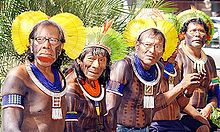 Brazilian Indigenous chiefs of the Kayapo tribe: Raony, Kaye, Kadjor, Panara
Brazilian Indigenous chiefs of the Kayapo tribe: Raony, Kaye, Kadjor, Panara
The Amerindians make up 0.4% of Brazil's population, or about 700,000 people.[72] Indigenous peoples are found in the entire territory of Brazil, although the majority of them live in Indian reservations in the North and Centre-Western part of the country. On 18 January 2007, FUNAI reported that it had confirmed the presence of 67 different uncontacted tribes in Brazil, up from 40 in 2005. With this addition Brazil has now overtaken the island of New Guinea as the country having the largest number of uncontacted tribes.[126]
Canada
Main article: Aboriginal peoples in Canada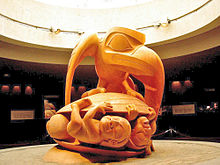 Bill Reid's sculpture The Raven and The First Men. The Raven represents the Trickster figure common to many mythologies.
Bill Reid's sculpture The Raven and The First Men. The Raven represents the Trickster figure common to many mythologies.
Aboriginal peoples in Canada comprise the First Nations,[127] Inuit[128] and Métis;[129] the descriptors "Indian" and "Eskimo" are falling into disuse.[130] Hundreds of Aboriginal nations evolved trade, spiritual and social hierarchies. The Métis culture of mixed blood originated in the mid-17th century when First Nation and native Inuit married European settlers.[131] The Inuit had more limited interaction with European settlers during that early period.[132] Various laws, treaties, and legislation have been enacted between European immigrants and First Nations across Canada. Aboriginal Right to Self-Government provides opportunity to manage historical, cultural, political, health care and economic control aspects within first people's communities.
Although not without conflict, European/Canadian early interactions with First Nations and Inuit populations were relatively peaceful, compared to the experience of native peoples in the United States. Combined with relatively late economic development in many regions, this peaceful history has allowed Canadian Indigenous peoples to have a relatively strong influence on the national culture while preserving their own identity.[133] National Aboriginal Day recognises the cultures and contributions of Aboriginal peoples of Canada.[134] There are currently over 600 recognized First Nations governments or bands encompassing 1,172,790 2006 people spread across Canada with distinctive Aboriginal cultures, languages, art, and music.[135][136][137]
Chile
Main article: Indigenous peoples in ChileAccording to the 2002 Census, 4.6% of the Chilean population, including the Rapanui of Easter Island, was indigenous, although most show varying degrees of miscegenation.[138] Many are descendants of the Mapuche, and live in Santiago, Araucanía and the lake district. The Mapuche successfully fought off defeat in the first 300–350 years of Spanish rule during the Arauco War. Relations with the new Chilean Republic were good until the Chilean state decided to occupy their lands. During the Occupation of Araucanía the Mapuche surrendered to the country's army in the 1880s. Their land was opened to settlement by Chileans and Europeans. Conflict over Mapuche land rights continued until present days.
Other groups include the Aimara who live mainly in Arica-Parinacota and Tarapacá Region and has the mayority of their alikes living in Bolivia and Peru and the Alacalufe survivors who now reside mainly in Puerto Edén.
Colombia
Main article: Indigenous peoples in ColombiaA small minority today within Colombia's overwhelmingly Mestizo and Afro-Colombian population, Colombia's indigenous peoples nonetheless encompass at least 85 distinct cultures and more than 1,378,884 people.[139][140] A variety of collective rights for indigenous peoples are recognized in the 1991 Constitution.
One of these is the Muisca culture, a subset of the larger Chibcha ethnic group, famous for their use of gold, which led to the legend of El Dorado. At the time of the Spanish conquest, the Chibchas were the largest native civilization between the Incas and the Aztecs.
Costa Rica
There are over 60,000 inhabitants of Native American origins, representing 1.5% of the population. Most of them live in secluded reservations, distributed among eight ethnic groups: Quitirrisí (In the Central Valley), Matambú or Chorotega (Guanacaste), Maleku (Northern Alajuela), Bribri (Southern Atlantic), Cabécar (Cordillera de Talamanca), Guaymí (Southern Costa Rica, along the Panamá border), Boruca (Southern Costa Rica) and Térraba (Southern Costa Rica).
These native groups are characterized for their work in wood, like masks, drums and other artistic figures, as well as fabrics made of cotton.
Their subsistence is based on agriculture, having corn, beans and plantains as the main crops.
Ecuador
Main article: Indigenous peoples in EcuadorEcuador was the site of many indigenous cultures, and civilizations of different proportions. An early sedentary culture, known as the Valdivia culture, developed in the coastal region, while the Caras and the Quitus unified to form an elaborate civilization that ended at the birth of the Capital Quito. The Cañaris near Cuenca were the most advanced, and most feared by the Inca, due to their fierce resistance to the Incan expansion. Their architecture remains were later destroyed by Spaniards and the Incas.
Approximately 96.4% of Ecuador's Indigenous population are Highland Quichuas living in the valleys of the Sierra region. Primarily consisting of the descendents of Incans, they are Kichwa speakers and include the Caranqui, the Otavaleños, the Cayambi, the Quitu-Caras, the Panzaleo, the Chimbuelo, the Salasacan, the Tugua, the Puruhá, the Cañari, and the Saraguro. Linguistic evidence suggests that the Salascan and the Saraguro may have been the descendants of Bolivian ethnic groups transplanted to Ecuador as mitimaes.
Coastal groups, including the Awá, Chachi, and the Tsáchila, make up 0.24% percent of the indigenous population, while the remaining 3.35 percent live in the Oriente and consist of the Oriente Kichwa (the Canelo and the Quijos), the Shuar, the Huaorani, the Siona-Secoya, the Cofán, and the Achuar.
In 1986, indigenous people formed the first "truly" national political organization. The Confederation of Indigenous Nationalities of Ecuador (CONAIE) has been the primary political institution of the Indigenous since then and is now the second largest political party in the nation. It has been influential in national politics, contributing to the ouster of presidents Abdalá Bucaram in 1997 and Jamil Mahuad in 2000.
El Salvador
Much of El Salvador was home to the Pipil, Lenca, and a number of Maya. The Pipil lived in western El Salvador, spoke Nahuat, and had many settlements there most noticeably the Señorío of Cuzcatlán . The Pipil had no treasure but held land that had rich and fertile soil, good for farming. This both disappointed and garnered attention from the Spaniards who were shocked not to find gold or jewels in El Salvador like they did in other lands like Guatemala or Mexico, but later learned of the fertile land El Salvador had to offer and attempted to conquer it. Noticeable Meso-American Indigenous warriors to rise militarily against the Spanish are Prince Atonal and Atlacatl of the Pipil people in central El Salvador, and Princess Antu Silan Ulap of the Lenca people in eastern El Salvador, who saw the Spanish not as gods, but as barbaric invaders. After fierce battles, the Pipil successfully retreated the Spanish army lead by Pedro de Alvarado along with their mexican indian allies the (tlaxcalas) sending them back to Guatemala for some time. At first the Pipil people had repelled Spanish Attacks but after many other attacks and reinforcing their army with Guatemalan indians allies, the Spanish were able to conquer Cuzcatlán, later the Spanish after many struggles, were also able to conquered the Lenca people and eventually racial intermingling between the Spaniards and the Pipil and Lenca women resulted in Mestizo population which later would become today's El Salvador descendants. Today many Pipil and Indigenous populations live in small towns of El Salvador like Izalco, Panchimalco, Sacacoyo, and Nahuizalco.
Guatemala
Many of the indigenous peoples of Guatemala are of Maya heritage. Other groups are Xinca people and Garifuna.
Pure Maya account for some 40 percent of the population; although around 40 percent of the population speaks an indigenous language, those tongues (of which there are more than 20) enjoy no official status. Guatemala's majority population holds a percentage of 59.4% in White or Mestizo (of mixed White and Amerindian ancestry) people. The area of Livingston, Guatemala is highly influenced by the Caribbean and its population includes a combination of Mestizos and Garifuna people.
Honduras
About 5 percent of the population are of full-blooded Amerindian descent, but upwards to 80 percent more or the majority of Hondurans are mestizo or part-Amerindian with Caucasian, and about 10 percent are of Amerindian and/or African descent.[141] The main concentration of Amerindians in Honduras are in the rural westernmost areas facing Guatemala and to the Caribbean Sea coastline, as well on the Nicaraguan border.[141] The majority of indigenous people are Lencas, Miskitos to the east, Mayans, Pech, Sumos, and Tolupan.[141]
Mexico
Main article: Indigenous peoples of Mexico Benito Juárez, an indigenous Zapotec and President of Mexico from 1858 to 1872. He was the first president with indigenous roots in the Americas.
Benito Juárez, an indigenous Zapotec and President of Mexico from 1858 to 1872. He was the first president with indigenous roots in the Americas.
The territory of modern-day Mexico was home to numerous indigenous civilizations prior to the arrival of the Spanish conquistadores: The Olmecs, who flourished from between 1200 BCE to about 400 BCE in the coastal regions of the Gulf of Mexico; the Zapotecs and the Mixtecs, who held sway in the mountains of Oaxaca and the Isthmus of Tehuantepec; the Maya in the Yucatán (and into neighbouring areas of contemporary Central America); the P'urhépecha or Tarascan in present day Michoacán and surrounding areas, and the Aztecs/Mexica, who, from their central capital at Tenochtitlan, dominated much of the centre and south of the country (and the non-Aztec inhabitants of those areas) when Hernán Cortés first landed at Veracruz.
In contrast to what was the general rule in the rest of North America, the history of the colony of New Spain was one of racial intermingling (mestizaje). Mestizos quickly came to account for a majority of the colony's population; however, significant numbers and communities of indígenas (as the native peoples are now known) survive to the present day. The CDI identifies 62 indigenous groups in Mexico, each with a unique language.[142]
In the states of Chiapas and Oaxaca and in the interior of the Yucatán peninsula the majority of the population is indigenous. Large indigenous minorities, including Aztecs or Nahua, P'urhépechas, Mazahua, Otomi, and Mixtecs are also present in the central regions of Mexico. In Northern Mexico indigenous people are a small minority.
The "General Law of Linguistic Rights of the Indigenous Peoples" grants all indigenous languages spoken in Mexico, regardless of the number of speakers, the same validity as Spanish in all territories in which they are spoken, and indigenous peoples are entitled to request some public services and documents in their native languages.[143] Along with Spanish, the law has granted them — more than 60 languages — the status of "national languages". The law includes all Amerindian languages regardless of origin; that is, it includes the Amerindian languages of ethnic groups non-native to the territory. As such the National Commission for the Development of Indigenous Peoples recognizes the language of the Kickapoo, who immigrated from the United States,[144] and recognizes the languages of the Guatemalan Amerindian refugees.[145] The Mexican government has promoted and established bilingual primary and secondary education in some indigenous rural communities. Nonetheless, of the indigenous peoples in Mexico, only about 67% of them (or 5.4% of the country's population) speak an Amerindian language and about a sixth do not speak Spanish (1.2% of the country's population).[146]
The indigenous peoples in Mexico have the right of free determination under the second article of the constitution. According to this article the indigenous peoples are granted:[147]
- the right to decide the internal forms of social, economic, political and cultural organization;
- the right to apply their own normative systems of regulation as long as human rights and gender equality are respected;
- the right to preserve and enrich their languages and cultures;
- the right to elect representatives before the municipal council in which their territories are located;
amongst other rights.
Nicaragua
Main article: MiskitoThe Miskito are a native people in Central America. Their territory extended from Cape Camarón, Honduras, to Rio Grande, Nicaragua along the Mosquito Coast. There is a native Miskito language, but large groups speak Miskito Coastal Creole, Spanish, Rama and other languages. The Creole English came about through frequent contact with the British who colonized the area. Many are Christians.
Traditional Miskito society was highly structured with a defined political structure. There was a king, but he did not have total power. Instead, the power was split between himself, a governor, a general, and by the 1750s, an admiral. Historical information on kings is often obscured by the fact that many of the kings were semi-mythical.
Peru
Main article: Indigenous Peoples in PeruIndigenous population in Peru make up around 30%[116] Native Peruvian traditions and customs have shaped the way Peruvians live and see themselves today. Cultural citizenship—or what Renato Rosaldo has called, "the right to be different and to belong, in a democratic, participatory sense" (1996:243)—is not yet very well developed in Peru. This is perhaps no more apparent than in the country's Amazonian regions where indigenous societies continue to struggle against state-sponsored economic abuses, cultural discrimination, and pervasive violence.[148]
United States
Main article: Native Americans in the United States A Choctaw Belle in 1850, painted by P. Romer
A Choctaw Belle in 1850, painted by P. Romer
Indigenous peoples in what is now the contiguous United States are commonly called "American Indians", or just "Indians" domestically, but are also often referred to as "Native Americans". In Alaska, indigenous peoples, which include Native Americans, Yupik and Inupiat Eskimos, and Aleuts, are referred to collectively as Alaska Natives.
Native Americans and Alaska Natives make up 2 percent of the population, with more than 6 million people identifying themselves as such, although only 1.8 million are recognized as registered tribal members. Tribes have established their own rules for membership, some of which are increasingly exclusive. More people have unrecognized Native American ancestry together with other ethnic groups. A minority of U.S. Native Americans live in land units called Indian reservations. Some southwestern U.S. tribes, such as the Yaqui and Apache, have registered tribal communities in Northern Mexico. Similarly, some northern bands of Blackfoot reside in southern Alberta, Canada, in addition to within US borders.
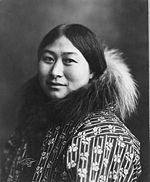 An Inuit woman
An Inuit woman
A number of Kumeyaay communities may be found in the Mexican State of Baja California.
Venezuela
Main article: Indigenous peoples in VenezuelaMost Venezuelans have some indigenous heritage, but the indigenous population make up only around 2% of the total population. They speak around 29 different languages and many more dialects, but some of the ethnic groups are very small and their languages are in danger of becoming extinct in the next decades. The most important indigenous groups are the Ye'kuana, the Wayuu, the Pemon and the Warao. The most advanced native people to have lived in present-day Venezuela is thought to have been the Timoto-cuicas, who mainly lived in the Venezuelan Andes. In total it is estimated that there were between 350 thousand and 500 thousand inhabitants, the most densely populated area being the Andean region (Timoto-cuicas), thanks to the advanced agricultural techniques used.
The 1999 constitution of Venezuela gives them special rights, although the vast majority of them still live in very critical conditions of poverty. The largest groups receive some basic primary education in their languages.
Other parts of the Americas
Indigenous peoples make up the majority of the population in Bolivia and Peru, and are a significant element in most other former Spanish colonies. Exceptions to this include Costa Rica, Cuba, Puerto Rico, Argentina, Dominican Republic, and Uruguay. At least four of the native American languages (Quechua in Peru and Bolivia; Aymara also in Peru, Bolivia and Chile, Guaraní in Paraguay, and Greenlandic in Greenland) are recognized as official languages languages (or Aymara in Chile, by regional basis).
Native American name controversy
Main article: Native American name controversyThe Native American name controversy is an ongoing dispute over the acceptable ways to refer to the indigenous peoples of the Americas and to broad subsets thereof, such as those living in a specific country or sharing certain cultural attributes. Once-common terms like "Indian" remain in use, despite the introduction of terms such as "Native American" and "Amerindian" during the latter half of the 20th century.[149][150][151]
Rise of indigenous movements
Part of a series on Indigenous rights 
Rights Human rights · Racial Discrimination
Self-determination · Forced assimilation
Forced relocation · Cultural heritage
Freedom of religion · Cultural diversity
Land rights · Traditional knowledge
Intellectual property · Language
Land use planning · Right to Identity
Conflict Resolution · Gender equalityGovernmental organizations UNPFII · ACHPR · AADNC · Arctic Council
FUNAI · Council of Indigenous Peoples
CDI · NCIP · Bureau of Indian AffairsNGOs and political groups Amazon Watch · AFN · CAP · COICA
CONAIE · Cultural Survival · EZLN · fPcN
IPACC · IPCB · IWGIA · NARF · ONIC
Survival International · UNPO · (more)Issues Colonialism · Civilizing mission / Manifest Destiny
Cultural genocide · Postdevelopment theory
Bantustan · Indian reservation · Indian reserveLegal Representation ILO 169 · United Nations Declaration Related Categories Organizations · Politics · Books · Activists
Publications · Documentaries · MoviesIn recent years, there has been a rise of indigenous movements in the Americas (mainly South America). These are rights-driven groups that organize themselves in order to achieve some sort of self-determination and the preservation of their culture for their peoples. Organizations like the Coordinator of Indigenous Organizations of the Amazon River Basin and the Indian Council of South America are examples of movements that are breaking the barrier of borders in order to obtain rights for Amazonian indigenous populations everywhere. Similar movements for indigenous rights can also be seen in Canada and the United States, with movements like the International Indian Treaty Council and the accession of native Indian group into the Unrepresented Nations and Peoples Organization.
There has also been a recognition of indigenous movements on an international scale, with the United Nations adopting the Declaration on the Rights of Indigenous Peoples, despite dissent from the stronger countries of the Americas.
In Colombia, various indigenous groups protested the denial of their rights. People organized a march in Cali in October 2008 to demand the government live up to promises to protect indigenous lands, defend the indigenous against violence, and reconsider the free trade pact with the United States.[152]
Legal prerogative
With the rise to power of governments in Venezuela, Ecuador, Paraguay, and especially Bolivia where Evo Morales was the first indigenous descendant elected president of Bolivia, the indigenous movement gained a strong foothold.
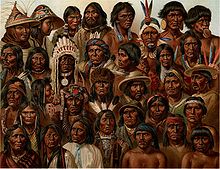 Amerikanska folk (American people), from the Nordisk familjebok (1904), vol. 1., accredited to the Bibliographisches Institut, Leipzig
Amerikanska folk (American people), from the Nordisk familjebok (1904), vol. 1., accredited to the Bibliographisches Institut, Leipzig
Representatives from indigenous and rural organizations from major South American countries, including Bolivia, Ecuador, Colombia, Chile and Brazil, started a forum in support of Morales' legal process of change. The meeting condemned plans by the European "foreign" power elite to destabilize the country. The forum also expressed solidarity with the Morales and his economic and social changes in the interest of historically marginalized majorities. Furthermore, in a cathartic blow to the US-backed elite, it questioned US interference through diplomats and NGO's. The forum was suspicious of plots against Bolivia and other countries, including Cuba, Venezuela, Ecuador, Paraguay and Nicaragua.[153]
The forum rejected the supposed violent method used by regional civic leaders from the called "Crescent departments" in Bolivia to impose their autonomous statutes, applauded the decision to expel the US ambassador to Bolivia, and reafirmed the sovereignty and independence of the presidency. Amongst others, representatives of CONAIE, the National Indigenous Organization of Colombia, the Chilean Council of All Lands, and the Brazilian Landless Movement participated in the forum.[153]
Genetics
Main article: Genetic history of indigenous peoples of the AmericasSee also: Y-DNA haplogroups in Indigenous peoples of the AmericasGenetic history of indigenous peoples of the Americas primarily focus on Human Y-chromosome DNA haplogroups and Human mitochondrial DNA haplogroups. "Y-DNA" is passed solely along the patrilineal line, from father to son, while "mtDNA" is passed down the matrilineal line, from mother to offspring of both sexes. Neither recombines, and thus Y-DNA and mtDNA change only by chance mutation at each generation with no intermixture between parents' genetic material.[154] Autosomal "atDNA" markers are also used, but differ from mtDNA or Y-DNA in that they overlap significantly.[155] AtDNA is generally used to measure the average continent-of-ancestry genetic admixture in the entire human genome and related isolated populations.[155]
The genetic pattern indicates Indigenous Amerindians experienced two very distinctive genetic episodes; first with the initial-peopling of the Americas, and secondly with European colonization of the Americas.[29][156][157] The former is the determinant factor for the number of gene lineages, zygosity mutations and founding haplotypes present in today's Indigenous Amerindian populations.[156]
Human settlement of the New World occurred in stages from the Bering sea coast line, with an initial 15, 000 to 20,000-year layover on Beringia for the small founding population.[29][158][159] The micro-satellite diversity and distributions of the Y lineage specific to South America indicates that certain Amerindian populations have been isolated since the initial colonization of the region.[160] The Na-Dené, Inuit and Indigenous Alaskan populations exhibit haplogroup Q (Y-DNA) mutations, however are distinct from other indigenous Amerindians with various mtDNA and atDNA mutations.[161][162][163] This suggests that the earliest migrants into the northern extremes of North America and Greenland derived from later migrant populations.[164][165]
See also
- Classification of indigenous peoples of the Americas
- Alaska Natives
- History of the west coast of North America
- Hyphenated American
- Indigenous languages of the Americas
- Indigenous Movements in the Americas
- Indigenous rights
- List of American Inuit
- List of Greenlandic Inuit
- List of indigenous artists of the Americas
- List of indigenous people of the Americas
- List of traditional territories of the indigenous peoples of North America
- List of writers from peoples indigenous to the Americas
- Mongoloid race
- Native American art
- Native American Languages Act of 1990
- Native American religion
- Native Hawaiians
- Pacific Islander
- Population history of American indigenous peoples
- Uncontacted peoples
- Zambo
References
- ^ "CIA, The World Factbook Peru" (PDF). https://www.cia.gov/library/publications/the-world-factbook/geos/pe.html#People. Retrieved 2011-07-12.
- ^ a b "Síntesis de Resultados". Comisión Nacional para el Desarrollo de los Pueblos Indígenas. 2006. http://www.cdi.gob.mx/cedulas/sintesis_resultados_2005.pdf. Retrieved 2010-12-22.
- ^ "CIA - The World Factbook". Cia.gov. https://www.cia.gov/library/publications/the-world-factbook/geos/bl.html. Retrieved 2011-02-23.
- ^ "CIA - The World Factbook". Cia.gov. https://www.cia.gov/library/publications/the-world-factbook/geos/gt.html#People. Retrieved 2011-02-23.
- ^ United States Central Bureau of Statistics (2001-2005 surveys)
- ^ DANE 2005 National Census
- ^ Canada 2006 Census
- ^ "Brazil urged to protect Indians". BBC News. 2005-03-30. http://news.bbc.co.uk/2/hi/americas/4392805.stm.
- ^ 2002 Chilean Census
- ^ a b INDEC: Encuesta Complementaria de Pueblos Indígenas (ECPI) 2004 - 2005
- ^ http://lcweb2.loc.gov/frd/cs/profiles/Venezuela.pdf
- ^ 2005 Census
- ^ "CIA - The World Factbook". Cia.gov. https://www.cia.gov/library/publications/the-world-factbook/geos/pm.html. Retrieved 2011-02-23.
- ^ http://convergencia.uaemex.mx/rev38/38pdf/LIZCANO.pdf
- ^ "Una comunidad indígena salvadoreña pide su reconocimiento constitucional en el país". soitu.es. http://www.soitu.es/soitu/2008/08/09/info/1218307640_720352.html. Retrieved 2011-02-23.
- ^ a b "Terminology". Indian and Northern Affairs Canada. http://www.ainc-inac.gc.ca/ap/tln-eng.asp. Retrieved 2009-11-11. "The Canadian Constitution recognizes three groups of Aboriginal people — Indians (First Nations), Métis and Inuit. These separate peoples have unique heritages, languages, cultural practices, and spiritual beliefs"
- ^ a b "Terminology of First Nations Native, Aboriginal and Indian" (PDF). the Office of the Aboriginal Advisor for Aboriginals. http://www.aidp.bc.ca/terminology_of_native_aboriginal_metis.pdf. Retrieved 2009-11-11. "Native is a word similar in meaning to Aboriginal. Native Peoples or First peoples is a collective term to describe the descendants of the original peoples of North America"
- ^ Jacobs, James Q. (2001). "The Paleoamericans: Issues and Evidence Relating to the Peopling of the New World". Anthropology and Archaeology Pages. jqjacobs.net. http://www.jqjacobs.net/anthro/paleoamericans.html. Retrieved 14 September 2009.
- ^ a b Jacobs, James Q. (2002). "Paleoamerican Origins: A Review of Hypotheses and Evidence Relating to the Origins of the First Americans". Anthropology and Archaeology Pages. jqjacobs.net. http://www.jqjacobs.net/anthro/paleoamerican_origins.html. Retrieved 14 September 2009.
- ^ Wilton, David (2004-12-02). Word myths: debunking linguistic urban legends. Oxford University Press, USA. p. 163. ISBN 978-0195172843. http://books.google.com/books?id=cp0r3aa8EM8C&pg=PA163&lpg=PA163&dq=indian+%22in+dios%22+wilton&source=web&ots=W-NiF2NqFJ&sig=fbsd08E-hqFNtusM30eS20dLky0#v=onepage&q&f=false. Retrieved 2011-07-03.
- ^ Adams, Cecil (2001-10-25). "Does "Indian" derive from Columbus's description of Native Americans as "una gente in Dios"?". The Straight Dope. http://www.straightdope.com/columns/read/1966/does-indian-derive-from-columbuss-description-of-native-americans-as-una-gente-in-dios. Retrieved 2011-07-03.
- ^ Zimmer, Ben (2009-10-12). "The Biggest Misnomer of All Time?". VisualThesaurus. http://www.visualthesaurus.com/cm/wordroutes/2015/.
- ^ Hoxie, Frederick E. (1996). Encyclopedia of North American Indians. Houghton Mifflin Harcourt. p. 568. ISBN 9780395669211.
- ^ Herbst, Philip (1997). The Color of Words: An Encyclopaedic Dictionary of Ethnic Bias in the United States. Intercultural Press. p. 116. ISBN 9781877864971. http://books.google.com/?id=UiZQH5gHuggC&pg=PA116.
- ^ Gómez-Moriana, Antonio (1993-05-12). "The Emerging of a Discursive Instance:Columbus and the invention of the "Indian"". Discourse Analysis as Sociocriticism : The Spanish Golden Age. University Of Minnesota Press. pp. 124–132. ISBN 978-0816620739. http://books.google.com/books?id=_BCpLZfypTIC&pg=PA124&dq=columbus+indios+indian&hl=en&ei=9BcRTrTmLc7OgAfBnompCA&sa=X&oi=book_result&ct=result&resnum=2&ved=0CC0Q6AEwAQ#v=onepage&q=columbus%20indios%20indian&f=false. Retrieved 2011-07-04.
- ^ a b Mann, Charles C. (2005). 1491: New Revelations of the Americas Before Columbus. New York: Knopf Publishing Group. ISBN 1-400-04006-X. OCLC 56632601.
- ^ Göran Burenhult: Die ersten Menschen, Weltbild Verlag, 2000. ISBN 3-8289-0741-5
- ^ a b "Atlas of the Human Journey-The Genographic Project". National Geographic Society.. 1996-2009. https://genographic.nationalgeographic.com/genographic/atlas.html?era=e003. Retrieved 2009-10-06.
- ^ a b c Wells, Spencer; Read, Mark (2002) (Digitised online by Google books). The Journey of Man - A Genetic Odyssey. Random House. pp. 138–140. ISBN 0812971469. http://books.google.com/books?id=WAsKm-_zu5sC&lpg=PP1&dq=The%20Journey%20of%20Man&pg=PA138#v=onepage&q&f=true. Retrieved 2009-11-21.
- ^ "Introduction". Government of Canada. Parks Canada. 2009. http://www.pc.gc.ca/eng/docs/r/pfa-fap/sec1.aspx. Retrieved 2010-01-09. "Canada's oldest known home is a cave in Yukon occupied not 12,000 years ago like the U.S. sites, but at least 20,000 years ago"
- ^ "Pleistocene Archaeology of the Old Crow Flats". Vuntut National Park of Canada. 2008. http://yukon.taiga.net/vuntutrda/archaeol/info.htm. Retrieved 2010-01-10. "However, despite the lack of this conclusive and widespread evidence, there are suggestions of human occupation in the northern Yukon about 24,000 years ago, and hints of the presence of humans in the Old Crow Basin as far back as about 40,000 years ago."
- ^ a b "Jorney of mankind". Brad Shaw Foundation. http://www.bradshawfoundation.com/journey/. Retrieved 2009-11-17.
- ^ Fitzhugh, Drs. William; Goddard, Ives; Ousley, Steve; Owsley, Doug; Stanford., Dennis. "Paleoamerican". Smithsonian Institution Anthropology Outreach Office. http://www.si.edu/Encyclopedia_SI/nmnh/origin.htm. Retrieved 2009-01-15.
- ^ "The peopling of the Americas: Genetic ancestry influences health". Scientific American. http://www.physorg.com/news169474130.html. Retrieved 2009-11-17.
- ^ "Alternate Migration Corridors for Early Man in North America". American Antiquity, Vol. 44, No. 1 (Jan., 1979), p2. http://archaeology.about.com/gi/o.htm?zi=1/XJ&zTi=1&sdn=archaeology&cdn=education&tm=25&f=00&tt=13&bt=1&bts=1&zu=http%3A//www.jstor.org/stable/279189. Retrieved 2009-11-17.
- ^ "68 Responses to "Sea will rise ‘to levels of last Ice Age’"". Center for Climate Systems Research, Columbia University. http://www.realclimate.org/index.php/archives/2009/01/sea-will-rise-to-levels-of-last-ice-age/. Retrieved 2009-11-17.
- ^ "A single and early migration for the peopling of the Americas supported by mitochondrial DNA sequence data". The National Academy of Sciences of the US. National Academy of Sciences. http://www.pubmedcentral.nih.gov/articlerender.fcgi?artid=20009. Retrieved 2009-10-10.
- ^ "Method and Theory in American Archaeology" (Digitised online by Questia Media). Gordon Willey and Philip Phillips. University of Chicago. 1958. http://www.questia.com/PM.qst?a=o&d=6136197. Retrieved 2009-11-20.
- ^ Peter N. Jones (October 2002). American Indian Mtdna, Y Chromosome Genetic Data, and the Peopling of North America. Bauu Institute. p. 4. ISBN 9780972134910. http://books.google.com/books?id=FKmlyhxhw3sC&pg=PA4. Retrieved 13 July 2011.
- ^ "Method and Theory in American Archaeology" (Digitised online by Questia Media). Gordon Willey and Philip Phillips. University of Chicago. 1958. http://www.questia.com/PM.qst?a=o&d=6136197. Retrieved 2009-11-20.
- ^ Fernández-Armesto, Felipe (1987). Before Columbus: Exploration and Colonisation from the Mediterranean to the Atlantic: 1229-1492. New studies in medieval history series. Basingstoke, Hampshire: Macmillan Education. ISBN 0-333-40382-7. OCLC 20055667.
- ^ Sorenson, John L.; and Carl L. Johannessen (2006). "Biological evidence for pre-Columbian transoceanic voyages". In Victor H. Mair (ed.). Contact and Exchange in the Ancient World. Perspectives on the global past series. Honolulu: University of Hawaiʻi Press. pp. 238–297. ISBN 0-8248-2884-4. OCLC 62896389.
- ^ Wright, Ronald (2005). Stolen Continents: 500 Years of Conquest and Resistance in the Americas (1st Mariner Books ed.). Boston, MA: Houghton Mifflin. ISBN 0-618-49240-2. OCLC 57511483.
- ^ Richard Erdoes, Alfonso Ortiz, (Eds.) "American Indian Myths and Legends." Pantheon, 1985.
- ^ "Native Americans of North America", Microsoft Encarta Online Encyclopedia 2006, Trudy Griffin-Pierce. Retrieved September 14, 2006. Archived 2009-11-01.
- ^ a b "Espagnols-Indiens: le choc des civilisations" in L'Histoire, n°322, July–August 2007, pp.14–21
- ^ "Smallpox Through History". Smallpox Through History. http://encarta.msn.com/media_701508643/Smallpox_Through_History.html.
- ^ Junius P. Rodriguez (2007). Encyclopedia of slave resistance and rebellion, Volume 1. ISBN 9780313332722. http://books.google.com/?id=h86YKfO-9RgC&pg=PA184&dq=enriquillo+revolt#v=onepage&q=enriquillo%20revolt&f=false. Retrieved 1 July 2010.
- ^ David M. Traboulay (1994-09). Columbus and Las Casas: the conquest and Christianization of America, 1492-1566. ISBN 9780819196422. http://books.google.com/?id=7Jmi4Wb1DdsC&pg=PA44&dq=enriquillo+revolt#v=onepage&q=enriquillo%20revolt&f=false. Retrieved 1 July 2010.
- ^ "Laws of Burgos, 1512-1513". Faculty.smu.edu. http://faculty.smu.edu/bakewell/BAKEWELL/texts/burgoslaws.html. Retrieved 2010-05-23.
- ^ Cook, p. 1.
- ^ "BBC Smallpox: Eradicating the Scourge". Bbc.co.uk. 2009-11-05. http://www.bbc.co.uk/history/british/empire_seapower/smallpox_01.shtml. Retrieved 2010-05-23.
- ^ "The Story Of... Smallpox – and other Deadly Eurasian Germs". Pbs.org. http://www.pbs.org/gunsgermssteel/variables/smallpox.html. Retrieved 2010-05-23.
- ^ "American Indian Epidemics". Kporterfield.com. http://www.kporterfield.com/aicttw/articles/disease.html. Retrieved 2010-05-23.
- ^ "Smallpox: The Disease That Destroyed Two Empires". Allicinfacts.com. http://www.allicinfacts.com/epidemics07.htm. Retrieved 2010-05-23.
- ^ "Epidemics". Libby-genealogy.com. 2009-04-30. http://www.libby-genealogy.com/epidemics.htm. Retrieved 2010-05-23.
- ^ American plague, New Scientist
- ^ Oaxaca[dead link]
- ^ Smallpox's history in the world
- ^ "Stacy Goodling, "Effects of European Diseases on the Inhabitants of the New World"". Millersville.edu. Archived from the original on May 10, 2008. http://web.archive.org/web/20080510163413/http://www.millersville.edu/~columbus/papers/goodling.html. Retrieved 2010-05-23.
- ^ "Aboriginal Distributions 1630 to 1653". Natural Resources Canada.
- ^ "David A. Koplow, '' Smallpox: The Fight to Eradicate a Global Scourge''". Ucpress.edu. http://www.ucpress.edu/books/pages/9968/9968.ch01.html. Retrieved 2011-02-23.
- ^ Dutch Children's Disease Kills Thousands of Mohawks[dead link]
- ^ W.B. Spaulding. "Smallpox". Thecanadianencyclopedia.com. http://www.thecanadianencyclopedia.com/index.cfm?PgNm=TCE&Params=A1ARTA0007462. Retrieved 2010-05-23.
- ^ "Iroquois". Fourdir.com. http://www.fourdir.com/iroquois.htm. Retrieved 2010-05-23.
- ^ Lange, Greg (2003-01-23). "Smallpox epidemic ravages Native Americans on the northwest coast of North America in the 1770s". Historylink.org. http://www.historylink.org/essays/output.cfm?file_id=5100. Retrieved 2010-05-23.
- ^ "The first smallpox epidemic on the Canadian Plains: In the fur-traders' words". Pubmedcentral.nih.gov. http://www.pubmedcentral.nih.gov/articlerender.fcgi?artid=2094753. Retrieved 2010-05-23.
- ^ "Mountain Man Plain Indian Fur Trade". Thefurtrapper.com. http://www.thefurtrapper.com/. Retrieved 2010-05-23.
- ^ "Lewis Cass and the Politics of Disease: The Indian Vaccination Act of 1832". Muse.jhu.edu. http://muse.jhu.edu/login?uri=/journals/wicazo_sa_review/v018/18.2pearson01.html. Retrieved 2010-05-23.
- ^ "Wicazo Sa Review: Vol. 18, No. 2, The Politics of Sovereignty (Autumn, 2003), pp. 9–35". Links.jstor.org. http://links.jstor.org/sici?sici=0749-6427%28200323%2918%3A2%3C9%3ALCATPO%3E2.0.CO%3B2-H&size=LARGE&origin=JSTOR-enlargePage. Retrieved 2010-05-23.
- ^ Fineberg, Gail. "'500 Years of Brazil's Discovery'". Loc.gov. http://www.loc.gov/loc/lcib/0006/brazil.html. Retrieved 2010-05-23.
- ^ a b "Brazil urged to protect Indians". BBC News. 2005-03-30. http://news.bbc.co.uk/2/hi/americas/4392805.stm. Retrieved 2010-05-23.
- ^ See Varese (2004), as reviewed in Dean (2006).
- ^ Ancient Horse (Equus cf. E. complicatus), The Academy of Natural Sciences, Thomas Jefferson Fossil Collection, Philadelphia, PA, (See: species Equus scotti) Others died out at the end of the last ice age with other megafauna.
- ^ ""Native Americans: The First Farmers." ''AgExporter'' October 1, 1999". Allbusiness.com. http://www.allbusiness.com/agriculture-forestry-fishing-hunting/331083-1.html. Retrieved 2010-05-23.
- ^ Spooner, DM; et al. (2005). "A single domestication for potato based on multilocus amplified fragment length polymorphism genotyping". PNAS 102 (41): 14694–99. doi:10.1073/pnas.0507400102. PMC 1253605. PMID 16203994. http://www.pubmedcentral.nih.gov/articlerender.fcgi?tool=pmcentrez&artid=1253605. Lay summary
- ^ Miller, N (2008-01-29). "Using DNA, scientists hunt for the roots of the modern potato". American Association for the Advancement of Science. http://www.eurekalert.org/pub_releases/2008-01/uow-uds012908.php. Retrieved 2008-09-10.
- ^ Solis, JS; et al. (2007). "Molecular description and similarity relationships among native germplasm potatoes (Solanum tuberosum ssp. tuberosum L.) using morphological data and AFLP markers". Electronic Journal of Biotechnology 10 (3): 0. doi:10.2225/vol10-issue3-fulltext-14. http://www.scielo.cl/scielo.php?script=sci_arttext&pid=S0717-34582007000300011&lng=en&nrm=.
- ^ John Michael Francis (2005). Iberia and the Americas. ABC-CLIO. ISBN 9781851094219. http://books.google.com/?id=OMNoS-g1h8cC&pg=PA867&dq=artistic+potato.
- ^ "Technology, disease, and colonial conquests, sixteenth to eighteenth centuries: essays reappraising the guns and germs theories". George Raudzens (2003). BRILL. p.190. ISBN 0391042068
- ^ "The great Maya droughts: water, life, and death". Richardson Benedict Gill (2000). UNM Press. p.123. ISBN 0826327745
- ^ Owen, Wayne (2002). "Chapter 2 (TERRA–2): The History of Native Plant Communities in the South". Southern Forest Resource Assessment Final Report. U.S. Department of Agriculture, Forest Service, Southern Research Station. http://www.srs.fs.usda.gov/sustain/report/terra2/terra2.htm. Retrieved 2008-07-29.
- ^ David L. Lentz, ed (2000). Imperfect balance: landscape transformations in the Precolumbian Americas. New York: Columbia University Press. pp. 241–242. ISBN 0-231-11157-6.
- ^ Michael Pollan, The Omnivore's Dilemma
- ^ Atran, Scott: Medin, Douglas (2010) The Native Mind and the Cultural Construction of Nature, MIT Press
- ^ Skidmore, Joel (2006). "The Cascajal Block: The Earliest Precolumbian Writing". Mesoweb Reports & News. pp. 1–4. http://www.mesoweb.com/reports/Cascajal.pdf. Retrieved 14 September 2009.
- ^ Elizabeth Hill Boone, "Pictorial Documents and Visual Thinking in Postconquest Mexico". p. 158.
- ^ A sample of this sound is available at the Princeton Art Museum website.
- ^ ""Hair Pipes in Plains Indian Adornment" by John C. Ewers". Sil.si.edu. http://www.sil.si.edu/DigitalCollections/BAE/Bulletin164/tptoc.htm. Retrieved 2009-09-14.
- ^ a b c "Aboriginal Ancestory, 2006 Census". 2.statcan.gc.ca. 2010-05-19. http://www12.statcan.gc.ca/english/census06/data/topics/RetrieveProductTable.cfm?TPL=RETR&ALEVEL=3&APATH=3&CATNO=&DETAIL=0&DIM=&DS=99&FL=0&FREE=0&GAL=0&GC=99&GK=NA&GRP=1&IPS=&METH=0&ORDER=1&PID=89146&PTYPE=88971,97154&RL=0&S=1&ShowAll=No&StartRow=1&SUB=732&Temporal=2006&Theme=73&VID=0&VNAMEE=&VNAMEF=. Retrieved 2010-05-23.
- ^ a b Lizcano (2005), pg 218, Martinez-Torres (2008)
- ^ a b c "Overview of Race and Hispanic Origin, 2000 US Census (Page 3-4)" (PDF). http://www.census.gov/prod/2001pubs/c2kbr01-1.pdf. Retrieved 2010-05-23.
- ^ a b c d "Belize 2000 Housing and Population Census". Belize Central Statistical Office. 2000. http://celade.cepal.org/cgibin/RpWebEngine.exe/PortalAction?&MODE=MAIN&BASE=CPVBLZ2000&MAIN=WebServerMain.inl. Retrieved 2008-09-30.
- ^ a b c "CIA — The World Factbook — Costa Rica". Cia.gov. https://www.cia.gov/library/publications/the-world-factbook/geos/cs.html. Retrieved 2009-09-14.
- ^ a b c "El Salvador". CIA World Fact Book. 26 Apr 2010. https://www.cia.gov/library/publications/the-world-factbook/geos/es.html. Retrieved 9 May 2010.
- ^ Guatemala entry at The World Factbook
- ^ a b c Honduras entry at The World Factbook
- ^ a b c Nicaragua entry at The World Factbook
- ^ a b c Panama entry at The World Factbook
- ^ Dominica entry at The World Factbook
- ^ a b c Grenada entry at The World Factbook
- ^ a b c Haiti entry at The World Factbook
- ^ Puerto Rico entry at The World Factbook
- ^ Bonilla et al., Ancestral proportions and their association with skin pigmentation and bone mineral density in Puerto Rican women from New York City. Hum Gen (2004) 115: 57-58, and Reconstructing the population history of Puerto Rico by means of mtDNA phylogeographic analysis, Martinez-Cruzado et al, Am J Phys Anthropol. 2005 NCBI.nlm.nih.gov
- ^ Suriname entry at The World Factbook
- ^ "''Primeros Resultados de la Encuesta Complementaria de Pueblos Indígenas (ECPI)''" (PDF). http://www.indec.mecon.ar/nuevaweb/cuadros/2/ECPI_res_generales_junio2006.pdf. Retrieved 2010-05-23.
- ^ Argentina entry at The World Factbook
- ^ a b c Bolivia entry at The World Factbook
- ^ "População residente, por cor ou raça, segundo a situação do domicílio - Instituto Brasileiro de Geografia e Estatística" (PDF). http://www.ibge.gov.br/home/estatistica/populacao/tendencia_demografica/indigenas/tab1_1.pdf. Retrieved 2010-05-23.
- ^ Chile entry at The World Factbook
- ^ a b c Colombia entry at The World Factbook
- ^ a b c Ecuador entry at The World Factbook
- ^ Guyana entry at The World Factbook
- ^ "Paraguay." Pan-American Health Organization. (retrieved 12 July 2011)
- ^ Paraguay entry at The World Factbook
- ^ a b c d http://www.unicef.org/lac/PERU_revisado.pdf
- ^ "CIA World Factbook: Suriname". CIA. https://www.cia.gov/library/publications/the-world-factbook/geos/ns.html. Retrieved 23 Mar 2010.
- ^ a b c Uruguay entry at The World Factbook
- ^ Indigenous identification was treated in a complex way in the 2001 Census, which collected data on self-identification, capacity to speak an indigenous language, and learning an indigenous language as a child. CEPAL, "Los pueblos indígenas de Bolivia: diagnóstico sociodemográfico a partir del censo del 2001," 2005, p. 32
- ^ CEPAL, "Los pueblos indígenas de Bolivia: diagnóstico sociodemográfico a partir del censo del 2001," 2005, p. 42
- ^ CEPAL, "Los pueblos indígenas de Bolivia: diagnóstico sociodemográfico a partir del censo del 2001," 2005, p. 47
- ^ Gotkowitz, Laura (2007). A revolution for our rights: Indigenous struggles for land and justice in Bolivia, 1880–1952. Durham: Duke University Press. ISBN 0822340496.
- ^ Rivera Cusicanqui, Silvia (1987). Oppressed but not defeated: Peasant struggles among the Aymara and Qhechwa in Bolivia, 1900-1980. Geneva: United Nations Research Institute for Social Development.
- ^ a b c "Bolivian president Morales launches the "indigenous autonomy"". MercoPress. 2009-08-03. http://en.mercopress.com/2009/08/03/bolivian-president-morales-launches-the-indigenous-autonomy. Retrieved 2009-08-05.
- ^ "Bolivian Indians in historic step". BBC. 2009-08-03. http://news.bbc.co.uk/2/hi/americas/8180790.stm. Retrieved 2009-08-05.
- ^ Colitt, Raymond (2007-01-17). "Brazil sees traces of more isolated Amazon tribes". Reuters.com. http://www.reuters.com/article/latestCrisis/idUSN17285256. Retrieved 2010-05-23.
- ^ "Civilization.ca-Gateway to Aboriginal Heritage-Culture". Canadian Museum of Civilization Corporation. Government of Canada. May 12, 2006. http://www.civilization.ca/cmc/exhibitions/tresors/ethno/etb0170e.shtml. Retrieved 2009-09-18.
- ^ "Inuit Circumpolar Council (Canada)-ICC Charter". Inuit Circumpolar Council > ICC Charter and By-laws > ICC Charter. 2007. http://inuitcircumpolar.com/index.php?auto_slide=&ID=374&Lang=En&Parent_ID=¤t_slide_num=. Retrieved 2009-09-18.
- ^ "In the Kawaskimhon Aboriginal Moot Court Factum of the Federal Crown Canada" (PDF). Faculty of Law. University of Manitoba. 2007. p. 2. http://www.umanitoba.ca/law/newsite/kawaskimhon_factums/FINALWrittenSubmissionsofFederalCrown_windsor.pdf. Retrieved 2009-09-18.
- ^ Kaplam, Lawrence (2002). "Inuit or Eskimo: Which names to use?". Alaska Native Language Center, University of Alaska Fairbanks. http://www.uaf.edu/anlc/inuitoreskimo.html. Retrieved 2007-04-06.
- ^ "What to Search: Topics-Canadian Genealogy Centre-Library and Archives Canada". Ethno-Cultural and Aboriginal Groups. Government of Canada. 2009-05-27. http://www.collectionscanada.gc.ca/genealogie/022-905.004-e.html. Retrieved 2009-10-02.
- ^ "Innu Culture 3. Innu-Inuit 'Warfare'". 1999, Adrian Tanner Department of Anthropology-Memorial University of Newfoundland. http://www.heritage.nf.ca/aboriginal/innu_culture.html. Retrieved 2009-10-05.
- ^ A Dialogue on Foreign Policy. Department of Foreign Affairs and International Trade. 2003-01. pp. 15–16. http://www.foreign-policy-dialogue.ca/pdf/DialogueEng.pdf. Retrieved 2006-11-30.
- ^ "National Aboriginal Day History" (PDF). Indian and Northern Affairs Canada. http://dsp-psd.pwgsc.gc.ca/Collection/R32-179-2000E.pdf. Retrieved 2009-10-18.
- ^ "Assembly of First Nations - Assembly of First Nations-The Story". Assembly of First Nations. http://www.afn.ca/article.asp?id=59. Retrieved 2009-10-02.
- ^ "Civilization.ca-Gateway to Aboriginal Heritage-object". Canadian Museum of Civilization Corporation. May 12, 2006. http://www.civilization.ca/cmc/exhibitions/tresors/ethno/etb0000e.shtml. Retrieved 2009-10-02.
- ^ "Aboriginal Identity (8), Sex (3) and Age Groups (12) for the Population of Canada, Provinces, Territories, Census Metropolitan Areas and Census Agglomerations, 2006 Census - 20% Sample Data". Canada 2006 Census data products. Statistics Canada, Government of Canada. 06/12/2008. http://www12.statcan.ca/english/census06/data/topics/RetrieveProductTable.cfm?ALEVEL=3&APATH=3&CATNO=&DETAIL=0&DIM=&DS=99&FL=0&FREE=0&GAL=0&GC=99&GK=NA&GRP=1&IPS=&METH=0&ORDER=1&PID=89122&PTYPE=88971&RL=0&S=1&ShowAll=No&StartRow=1&SUB=0&Temporal=2006&Theme=73&VID=0&VNAMEE=&VNAMEF=&GID=837928. Retrieved 2009-09-18.
- ^ "El gradiente sociogenético chileno y sus implicaciones ético-sociales". Medwave.cl. 2000-06-15. http://www.medwave.cl/ciencia/11.act. Retrieved 2010-05-23.
- ^ DANE 2005 national census
- ^ "Health equity and ethnic minorities in emergency situations", Pier Paolo Balladelli, José Milton Guzmán, Marcelo Korc, Paula Moreno, Gabriel Rivera, The Commission on Social Health Determinants, Pan American Health Organization, World Health Organization, Bogotá, Colombia, 2007
- ^ a b c Bourgois, Philippe (Anthropology Today, Vol. 2, No. 2 (Apr., 1986), pp. 4-9). "The Miskitu of Nicaragua: Politicized Ethnicity". Royal Anthropological Institute of Great Britain and Ireland. http://www.jstor.org/stable/3033029. Retrieved 2010-01-05.
- ^ Ley General de Derechos Lingüísticos de los Pueblos Indígenas (PDF).
- ^ (Spanish) "Ley General de Derechos Lingüísticos de los Pueblos Indígenas (General Law of the Rights of the Indigenous Peoples)" (PDF). CDI México. Archived from the original on September 25, 2007. http://web.archive.org/web/20070925193420/http://cdi.gob.mx/derechos/vigencia/2006_ley_general_derechos_linguisticos_pueblos_indigenas.pdf. Retrieved 2007-10-02.
- ^ "Kikapúes — Kikaapoa". CDI México. http://www.cdi.gob.mx/index.php?id_seccion=291. Retrieved 2007-10-02.
- ^ "Aguacatecos, cakchiqueles, ixiles, kekchíes, tecos y quichés". CDI México. Archived from the original on 2007-09-26. http://web.archive.org/web/20070926232909/http://cdi.gob.mx/index.php?id_seccion=1378. Retrieved 2007-10-02.
- ^ "Poblicación de 5 años y más por Entidad Federativa, sexo y grupos lengüa indígena quinquenales de edad, y su distribución según condición de habla indígena y habla española" (PDF). INEGI, México. http://www.inegi.gob.mx/prod_serv/contenidos/espanol/bvinegi/productos/censos/poblacion/2000/definitivos/Nal/tabulados/00li01.pdf. Retrieved 2007-12-13.
- ^ Constitución Política de los Estados Unidos MexicanosPDF (779 KB). Second article.
- ^ Dean, Bartholomew 2009 Urarina Society, Cosmology, and History in Peruvian Amazonia, Gainesville: University Press of Florida ISBN 978-081303378, UPF.com
- ^ The American Heritage Dictionary of the English Language. Boston: Houghton Mifflin. 2000. ISBN 0-395-82517-2 (hardcover), ISBN 0-618-08230-1hardcover with CD ROM)
- ^ Mandel, Michael. The Charter of Rights and the Legalization of Politics in Canada. Revised, Updated and Expanded Edition. (Toronto: Thompson Educational Publishing, Inc., 1994), pp. 354-356.
- ^ ( R.S., 1985, c. I-5 )Canadian Constitution Act, 1982, Section Twenty-five of the Canadian Charter of Rights and Freedoms 35.
- ^ Africa.euters.com[dead link]
- ^ a b Plenglish.com[dead link]
- ^ "A Nomenclature System for the Tree of Human Y-Chromosomal Binary Haplogroups". Genome Research. 2002. pp. Vol. 12(2), 339–348. doi:10.1101/gr.217602. http://www.genome.org/cgi/content/full/12/2/339. Retrieved 2010-01-19. (Detailed hierarchical chart)
- ^ a b Griffiths, Anthony J. F. (1999). An Introduction to genetic analysis. New York: W.H. Freeman. ISBN 071673771X. http://www.ncbi.nlm.nih.gov/books/bv.fcgi?highlight=autosome&rid=iga.section.222. Retrieved 2010-02-03.
- ^ a b "Learn about Y-DNA Haplogroup Q. Genebase Tutorials" (Verbal tutorial possible). Genebase Systems. 2008. http://www.genebase.com/tutorial/item.php?tuId=16. Retrieved 2009-11-21.
- ^ Orgel L (2004). "Prebiotic chemistry and the origin of the RNA world" (PDF). Crit Rev Biochem Mol Biol 39 (2): 99–123. doi:10.1080/10409230490460765. PMID 15217990. http://www.d.umn.edu/~pschoff/documents/OrgelRNAWorld.pdf. Retrieved 2010-01-19.
- ^ First Americans Endured 20,000-Year Layover — Jennifer Viegas, Discovery News. Discovery Channel. http://dsc.discovery.com/news/2008/02/13/beringia-native-american.html. Retrieved 2009-11-18 page 2
- ^ Than, Ker (2008). "New World Settlers Took 20,000-Year Pit Stop". National Geographic Society. http://news.nationalgeographic.com/news/2008/02/080214-america-layover.html. Retrieved 2010-01-23.
- ^ "Summary of knowledge on the subclades of Haplogroup Q". Genebase Systems. 2009. http://64.40.115.138/file/lu/6/52235/NTIyMzV9K3szNTc2Nzc=.jpg?download=1. Retrieved 2009-11-22.
- ^ Ruhlen M (November 1998). "The origin of the Na-Dene". Proceedings of the National Academy of Sciences of the United States of America 95 (23): 13994–6. doi:10.1073/pnas.95.23.13994. PMC 25007. PMID 9811914. http://www.pnas.org/cgi/pmidlookup?view=long&pmid=9811914.
- ^ Zegura SL, Karafet TM, Zhivotovsky LA, Hammer MF (January 2004). "High-resolution SNPs and microsatellite haplotypes point to a single, recent entry of Native American Y chromosomes into the Americas". Molecular Biology and Evolution 21 (1): 164–75. doi:10.1093/molbev/msh009. PMID 14595095.
- ^ "mtDNA Variation among Greenland Eskimos. The Edge of the Beringian Expansion". Laboratory of Biological Anthropology, Institute of Forensic Medicine, University of Copenhagen, Copenhagen, McDonald Institute for Archaeological Research,University of Cambridge, Cambridge, University of Hamburg, Hamburg. 2000. doi:10.1086/303038. http://www.cell.com/AJHG/abstract/S0002-9297%2807%2963257-1. Retrieved 2009-11-22.
- ^ "The peopling of the New World — Perspectives from Molecular Anthropology". Department of Anthropology, University of Pennsylvania. Annual Review of Anthropology. 2004. pp. Vol. 33, 551–583. doi:10.1146/annurev.anthro.33.070203.143932. http://arjournals.annualreviews.org/doi/abs/10.1146/annurev.anthro.33.070203.143932?journalCode=anthro. Retrieved 2010-02-03.
- ^ "Native American Mitochondrial DNA Analysis Indicates That the Amerind and the Nadene Populations Were Founded by Two Independent Migrations". Center for Genetics and Molecular Medicine and Departments of Biochemistry and Anthropology, Emory University School of Medicine, Atlanta, Georgia. Genetics Society of America. Vol 130, 153-162. http://www.genetics.org/cgi/reprint/130/1/153. Retrieved 2009-11-28.
Books
- König, Eva (2002). Indianer 1858-1928, Photographische Reisen von Alaska bis Feuerland. Museum für Volkerkunde Hamburg: Edition Braus. ISBN 3-89904-021-X.
- Cappel, Constance (2007). The Smallpox Genocide of the Odawa Tribe at L'Arbre Croche, 1763: The History of a Native American People. Lewiston, N.Y.: Edwin Mellen Press. ISBN 978-0-7734-5220-6. OCLC 175217515.
- Cappel, Constance,(editor) (2006). Odawa Language and Legends: Andrew J. Blackbird and Raymond Kiogima. Xlibris. ISBN 1-59926-920-1.
- Churchill, Ward (1997). A Little Matter of Genocide: Holocaust and Denial in the Americas, 1492 to the Present. San Francisco: City Lights Books. ISBN 978-0-87286-323-1. OCLC 35029491. http://books.google.com/?id=QXRyTRavzK4C&printsec=frontcover&dq=A+Little+Matter+of+Genocide:+Holocaust+and+Denial+in+the+Americas,+1492+to+the+Present#v=onepage&q=.
- Dean, Bartholomew (2002). "State Power and Indigenous Peoples in Peruvian Amazonia: A Lost Decade, 1990–2000". In Maybury-Lewis, David. The Politics of Ethnicity: Indigenous Peoples in Latin American States. David Rockefeller Center series on Latin American studies, Harvard University. 9. Cambridge, Mass.: Harvard University/David Rockefeller Center for Latin American Studies. pp. 199–238. ISBN 0-674-00964-9. OCLC 427474742.
- Dean, Bartholomew; Levi, Jerome M. (2003). At the Risk of Being Heard: Identity, Indigenous Rights, and Postcolonial States. Ann Arbor: University of Michigan Press. ISBN 978-0-472-09736-4. OCLC 50841012. http://books.google.com/?id=ESutGButMOAC&printsec=frontcover&dq=At+the+Risk+of+Being+Heard:+Identity,+Indigenous+Rights,+and+Postcolonial+States#v=onepage&q=.
- Dean, Bartholomew (January 2006). "Salt of the Mountain: Campa Asháninka History and Resistance in the Peruvian Jungle (review)". The Americas 62 (3): 464–466. doi:10.1353/tam.2006.0013. ISSN 0003-1615. http://muse.jhu.edu/login?uri=/journals/the_americas/v062/62.3dean.html.
- Kane, Katie (1999). "Nits Make Lice: Drogheda, Sand Creek, and the Poetics of Colonial Extermination". Cultural Critique (University of Minnesota Press) 42 (42): 81–103. doi:10.2307/1354592. ISSN 0882-4371. JSTOR 1354592.
- Krech, Shepard III (1999). The Ecological Indian: Myth and History. New York: W. W. Norton & Company. ISBN 978-0-393-04755-4. OCLC 318358852. http://books.google.com/?id=on7tKuPdlaMC&printsec=frontcover&dq=The+Ecological+Indian:+Myth+and+History#v=onepage&q=.
- Varese, Stefano; Ribeiro, Darcy (2004) [2002]. Salt of the Mountain: Campa Ashaninka History and Resistance in the Peruvian Jungle. trans. Susan Giersbach Rascón. Norman: University of Oklahoma Press. ISBN 0-8061-3512-3. OCLC 76909908. http://books.google.com/?id=NCXw6o3YaMkC&printsec=frontcover&dq=Salt+of+the+Mountain:+Campa+Ashaninka+History+and+Resistance+in+the+Peruvian+Jungle#v=onepage&q=.
External links
- The Peopling of the American Continents, Early California History
- North America, Indigenous Peoples Issues and Resources
- South America, Indigenous Peoples Issues and Resources
- Indigenous Peoples in Brazil. Instituto Socioambiental (ISA)
- America's Stone Age explorers, PBS Nova
- A history of Native people of Canada - The Canadian Museum of Civilization
 Alexander Francis Chamberlain (1911). "Indians, North American". In Chisholm, Hugh. Encyclopædia Britannica (11th ed.). Cambridge University Press.
Alexander Francis Chamberlain (1911). "Indians, North American". In Chisholm, Hugh. Encyclopædia Britannica (11th ed.). Cambridge University Press.
Categories:- Indigenous peoples of the Americas
- History of indigenous peoples of the Americas
- Ethnic groups in the Americas
- Ethnic groups in Latin America
- Ethnic groups in North America
- Historical definitions of race
- Latin American caste system
Wikimedia Foundation. 2010.

